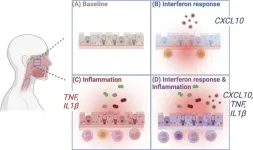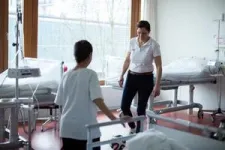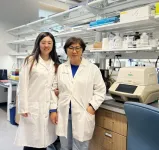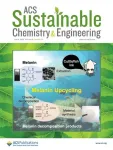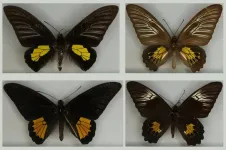(Press-News.org) Analyzing nasal swabs taken during the pandemic, researchers at Yale School of Medicine suggest that the frequent presence of other viruses and bacteria may have helped to protect children from the worst effects of COVID-19 by boosting their immune systems. Their results will be published July 1 in the Journal of Experimental Medicine (JEM).
Children are generally more susceptible than adults to respiratory infections such as the common cold, and yet, for unknown reasons, the SARS-CoV-2 virus tends to cause less severe symptoms in children than in adults, resulting in lower rates of hospitalization and death during the COVID-19 pandemic. The innate immune system provides the first line of defense against viruses and bacteria, quickly producing a variety of anti-viral and proinflammatory proteins to fend off infection while the body develops other, more targeted, immune responses such as antibodies. Studies have shown that, compared with adults, the innate immune system is more active in the nasal passages of children and might therefore be better at blocking the early stages of SARS-CoV-2 infection. But the reason for this increased activity is unknown.
“Prior work suggested that heightened nasal innate immunity in children was due to intrinsic biological mechanisms inherent to their age,” says Ellen F. Foxman, associate professor of Laboratory Medicine and Immunobiology at Yale School of Medicine and the senior author of the new JEM study. “But we thought it could also be due to the high burden of respiratory viruses and bacterial infections in children.”
To investigate whether frequent respiratory infections are responsible for elevating nasal innate immunity in children, Foxman and colleagues re-analyzed more than 600 nasal swabs originally taken during the pandemic from pediatric patients about to undergo elective surgery or emergency room evaluation. Initially tested only for the presence of SARS-CoV-2, Foxman and colleagues re-screened the samples for 19 different respiratory viruses and bacteria, as well as measuring the levels of antiviral and inflammatory proteins produced by the innate immune system.
The researchers found that many children—even those without any symptoms—were infected with respiratory pathogens other than SARS-CoV-2. This was especially true for younger children, with viruses or infection-causing bacteria being detected in around 50% of asymptomatic patients under five years old. Children with higher levels of respiratory pathogens showed higher levels of nasal innate immune activity, regardless of whether they were toddlers or teenagers.
To further investigate the relationship between respiratory infections and nasal innate immunity, Foxman’s team compared nasal swabs taken from healthy one-year-olds at both a routine well-child checkup and a follow-up appointment one to two weeks later. Over half of the children tested positive for a respiratory virus on one of their two visits to the pediatrician, indicating that they had either acquired or cleared an infection in the intervening period. In almost every case, the child’s innate immune activity was higher at the time they were infected and lower at the time when they were virus free.
“This reveals that nasal antiviral defenses are not continually on high alert in young children but are activated in response to acquisition of a respiratory virus, even when that virus is not causing symptoms,” says Foxman.
Taken together, the study’s results indicate that the innate immune system is often highly activated in the nasal passages of children because they are frequently infected with relatively benign pathogens, such as the rhinoviruses responsible for the common cold. Foxman speculates that young children have more infections with common seasonal viruses than adults because they have less immunological protection from prior exposures (such as antibodies). However, since SARS-CoV-2 was a new virus to the human population, neither adults nor children had prior protection when the COVID-19 pandemic began. In this situation, activation of generalized antiviral defenses in children by other infections may have helped to fight off the initial stages of SARS-CoV-2 infection, leading to less severe outcomes in children compared with adults.
“We have identified respiratory viruses and bacteria as key drivers of the enhanced nasal innate immunity in children,” Foxman says. “Our results compel further study of how seasonal respiratory viruses and nasal bacteria impact disease severity of COVID-19 and pediatric immune responses in general.”
Watkins et al. 2024. J. Exp. Med. https://rupress.org/jem/article-lookup/doi/10.1084/jem.20230911?PR
# # #
About Journal of Experimental Medicine
Journal of Experimental Medicine (JEM) publishes peer-reviewed research on immunology, cancer biology, stem cell biology, microbial pathogenesis, vascular biology, and neurobiology. All editorial decisions on research manuscripts are made through collaborative consultation between professional scientific editors and the academic editorial board. Established in 1896, JEM is published by Rockefeller University Press, a department of The Rockefeller University in New York. For more information, visit jem.org.
Visit our Newsroom, and sign up for a weekly preview of articles to be published. Embargoed media alerts are for journalists only.
Follow JEM on Twitter at @JExpMed and @RockUPress.
END
Common respiratory infections may have protected children from COVID-19, study suggests
2024-07-01
ELSE PRESS RELEASES FROM THIS DATE:
Ochsner Medical Center – Baton Rouge performs robotic-assisted lung biopsy
2024-07-01
BATON ROUGE, La. – Ochsner Medical Center – Baton Rouge now offers robotic-assisted bronchoscopy using the Ion robotic platform, a new, minimally invasive option for lung biopsy.
With bronchoscopy, doctors insert a long, thin tube with a camera to examine lung tissue and retrieve a biopsy sample. The Ion robot enables doctors to perform a biopsy quicker and safer than ever before.
These advancements are especially critical for treating lung cancer, since early detection is key to achieving the best outcome. Every six weeks of delayed treatment lowers ...
Daily sauna time might help prevent menopause-related weight gain
2024-07-01
Chicago (July 1, 2024) — New research performed with mice suggests that daily time in a warm environment such as a sauna might help older adults, especially women, combat age-related obesity and insulin resistance. The study shows the potential of heat treatments as a simple way to promote healthier aging.
The researchers found that older female mice receiving a daily 30-minute whole-body heat treatment gained less weight and showed improved use of insulin, which helps control blood sugar. The investigators ...
Researchers thwart resistant bacteria’s strategy
2024-07-01
Antibiotic resistant bacteria are experts in evolving new strategies to avoid being killed by antibiotics.
One such bacterium is Pseudomonas aeruginosa, which is naturally found in soil and water, but also hospitals, nursing homes and similar institutions for persons with weakened immune systems are home for strains of this bacterium. As many P. Aeruginosa strains found in hospitals are resistant to most antibiotics in use, science is forced to constantly search for new ways to kill them.
Now, at team of researchers from Department of Biochemistry and Molecular Biology and Department of ...
Finding the sweet spot in brain development
2024-07-01
Not everything in the brain is meant to last. As our brains assemble, trillions of neural connections have to be built or torn down at the right time and place. Otherwise, the seeds of disorders like autism can take root. Cold Spring Harbor Laboratory Assistant Professor Gabrielle Pouchelon studies how the brain is wired early in life. In doing so, she hopes to find the origins of various brain dysfunctions and new ways to treat them.
In a new study, Pouchelon and her team zero in on a process known as pruning. This is when the brain removes unnecessary connections between ...
New national volunteer leaders to guide American Heart Association into second century
2024-07-01
DALLAS, July 1, 2024 — The American Heart Association, celebrating 100 years of lifesaving service as the world’s leading nonprofit organization focused on heart and brain health for all, has named its volunteer leadership for fiscal year 2024-25. Keith Churchwell, M.D., FAHA, serving as the new volunteer president, and Marsha Jones, continuing a two-year term as volunteer board chairperson, will help guide the Association as it enters its second century. Churchwell and Jones are long-time volunteer leaders for ...
Geological Society of America reduces student membership dues to $25
2024-07-01
FOR IMMEDIATE RELEASE
1 July 2024
The Geological Society of America
Release No. 24-06
Contact: Jason Elkins
+1-303-357-1026
jelkins@geosociety.org
Boulder, Colo., USA: The Geological Society of America (GSA) is excited to announce a significant reduction in membership fees for students. Effective 1 July 2024, undergraduate and graduate students majoring in geology or related sciences can sign up for an annual student membership for just $25. This initiative underscores GSA's commitment to supporting the next generation of geoscientists by making membership more accessible and affordable.
The ...
Melanin from cuttlefish ink as a sustainable biomass resource
2024-07-01
Every year, the negative effects of human activities on the environment become increasingly clear. From climate change and microplastics to the endangerment and extinction of countless species, it is evident that we need to find new ways to achieve sustainability. Fortunately, many research groups in prominent fields like chemistry and materials science are tirelessly working to develop solutions to get us closer to circular and sustainable economies.
One area that has attracted much attention in this regard is biomass upcycling. It refers to the transformation of naturally available organic materials into ...
AI-powered study explores under-studied female evolution
2024-07-01
Pioneering AI-powered research on butterflies has probed the under-studied evolution of females and adds to a debate between the founding fathers of evolution.
The University of Essex study – published in Communications Biology – explores a controversy between Victorian scientists Charles Darwin and Alfred Russel Wallace.
Darwin thought males had more variation, as females often chose mates based on male appearance.
Whereas Wallace thought natural selection across sexes was the biggest factor in difference.
For over a century, scientists ...
New findings may fix the replicability crisis in microbiome research
2024-07-01
Our bodies are inhabited by trillions of microorganisms, with specific microbes unique to each individual. Through experimentation, scientists have pinpointed certain factors that account for variation in the gut: diet, living conditions, exercise and maternal line. Now, scientists at University of California San Diego have discovered another factor that affects the composition of the gut microbiome: time of day. In fact, the scientists have found that time of day is such an important factor that they’re calling on the National Institutes of Health (NIH) to require researchers ...
Nanorobot with hidden weapon kills cancer cells
2024-07-01
Researchers at Karolinska Institutet in Sweden have developed nanorobots that kill cancer cells in mice. The robot’s weapon is hidden in a nanostructure and is exposed only in the tumour microenvironment, sparing healthy cells. The study is published in the journal Nature Nanotechnology.
The research group at Karolinska Institutet has previously developed structures that can organise so-called death receptors on the surface of cells, leading to cell death. The structures exhibit six peptides (amino acid chains) assembled in a hexagonal pattern.
“This hexagonal nanopattern of peptides becomes a lethal weapon,” explains Professor ...
